Organizational Behavior in South Asian Countries: A Study
VerifiedAdded on 2022/08/20
|8
|2024
|11
Homework Assignment
AI Summary
This assignment explores organizational behavior within the context of South Asian countries, delving into key concepts such as power distance and collectivism and how they impact workplace dynamics. It examines the implications of high and low power distance cultures, contrasting employee behaviors and expectations in countries like China and Canada. The assignment also analyzes the five-factor model of personality, identifying conscientiousness and extraversion as critical traits for sales executive roles. Furthermore, it discusses the advantages and disadvantages of using stereotypes in the workplace, highlighting their potential impact on employee interactions, teamwork, and overall organizational culture. The document references several academic sources to support its arguments and provides a comprehensive overview of the challenges and opportunities related to organizational behavior in South Asian countries.
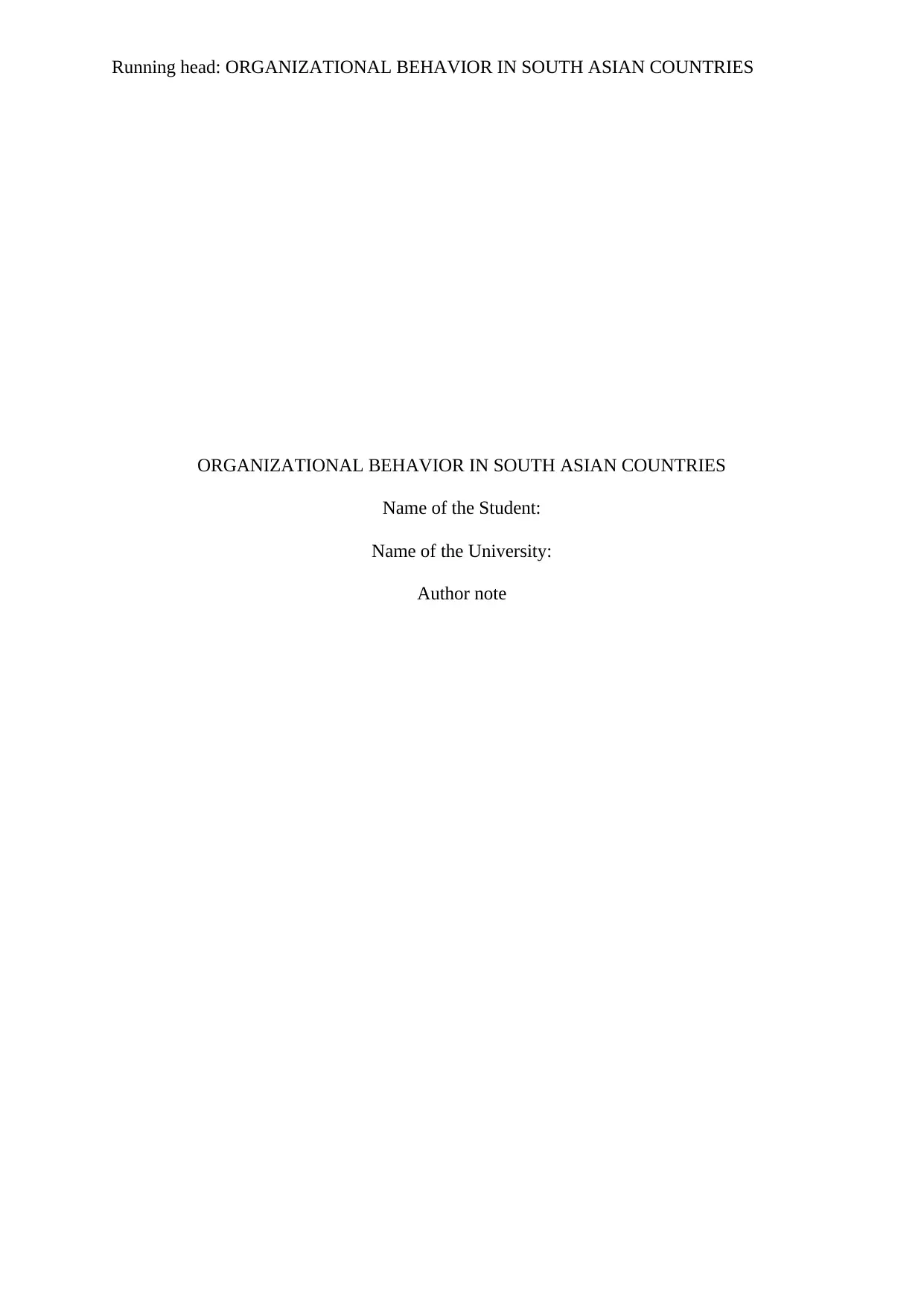
Running head: ORGANIZATIONAL BEHAVIOR IN SOUTH ASIAN COUNTRIES
ORGANIZATIONAL BEHAVIOR IN SOUTH ASIAN COUNTRIES
Name of the Student:
Name of the University:
Author note
ORGANIZATIONAL BEHAVIOR IN SOUTH ASIAN COUNTRIES
Name of the Student:
Name of the University:
Author note
Paraphrase This Document
Need a fresh take? Get an instant paraphrase of this document with our AI Paraphraser
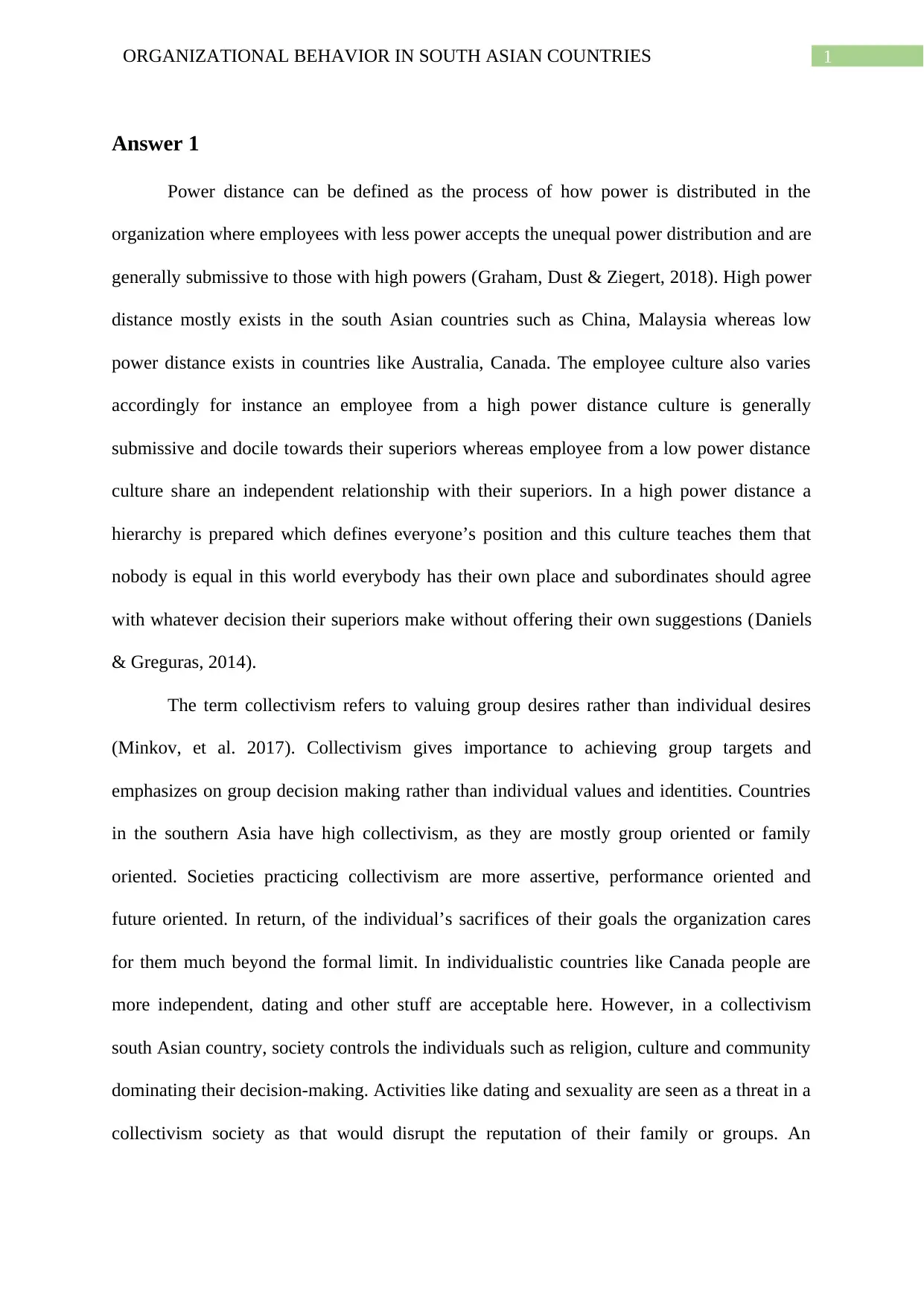
1ORGANIZATIONAL BEHAVIOR IN SOUTH ASIAN COUNTRIES
Answer 1
Power distance can be defined as the process of how power is distributed in the
organization where employees with less power accepts the unequal power distribution and are
generally submissive to those with high powers (Graham, Dust & Ziegert, 2018). High power
distance mostly exists in the south Asian countries such as China, Malaysia whereas low
power distance exists in countries like Australia, Canada. The employee culture also varies
accordingly for instance an employee from a high power distance culture is generally
submissive and docile towards their superiors whereas employee from a low power distance
culture share an independent relationship with their superiors. In a high power distance a
hierarchy is prepared which defines everyone’s position and this culture teaches them that
nobody is equal in this world everybody has their own place and subordinates should agree
with whatever decision their superiors make without offering their own suggestions (Daniels
& Greguras, 2014).
The term collectivism refers to valuing group desires rather than individual desires
(Minkov, et al. 2017). Collectivism gives importance to achieving group targets and
emphasizes on group decision making rather than individual values and identities. Countries
in the southern Asia have high collectivism, as they are mostly group oriented or family
oriented. Societies practicing collectivism are more assertive, performance oriented and
future oriented. In return, of the individual’s sacrifices of their goals the organization cares
for them much beyond the formal limit. In individualistic countries like Canada people are
more independent, dating and other stuff are acceptable here. However, in a collectivism
south Asian country, society controls the individuals such as religion, culture and community
dominating their decision-making. Activities like dating and sexuality are seen as a threat in a
collectivism society as that would disrupt the reputation of their family or groups. An
Answer 1
Power distance can be defined as the process of how power is distributed in the
organization where employees with less power accepts the unequal power distribution and are
generally submissive to those with high powers (Graham, Dust & Ziegert, 2018). High power
distance mostly exists in the south Asian countries such as China, Malaysia whereas low
power distance exists in countries like Australia, Canada. The employee culture also varies
accordingly for instance an employee from a high power distance culture is generally
submissive and docile towards their superiors whereas employee from a low power distance
culture share an independent relationship with their superiors. In a high power distance a
hierarchy is prepared which defines everyone’s position and this culture teaches them that
nobody is equal in this world everybody has their own place and subordinates should agree
with whatever decision their superiors make without offering their own suggestions (Daniels
& Greguras, 2014).
The term collectivism refers to valuing group desires rather than individual desires
(Minkov, et al. 2017). Collectivism gives importance to achieving group targets and
emphasizes on group decision making rather than individual values and identities. Countries
in the southern Asia have high collectivism, as they are mostly group oriented or family
oriented. Societies practicing collectivism are more assertive, performance oriented and
future oriented. In return, of the individual’s sacrifices of their goals the organization cares
for them much beyond the formal limit. In individualistic countries like Canada people are
more independent, dating and other stuff are acceptable here. However, in a collectivism
south Asian country, society controls the individuals such as religion, culture and community
dominating their decision-making. Activities like dating and sexuality are seen as a threat in a
collectivism society as that would disrupt the reputation of their family or groups. An
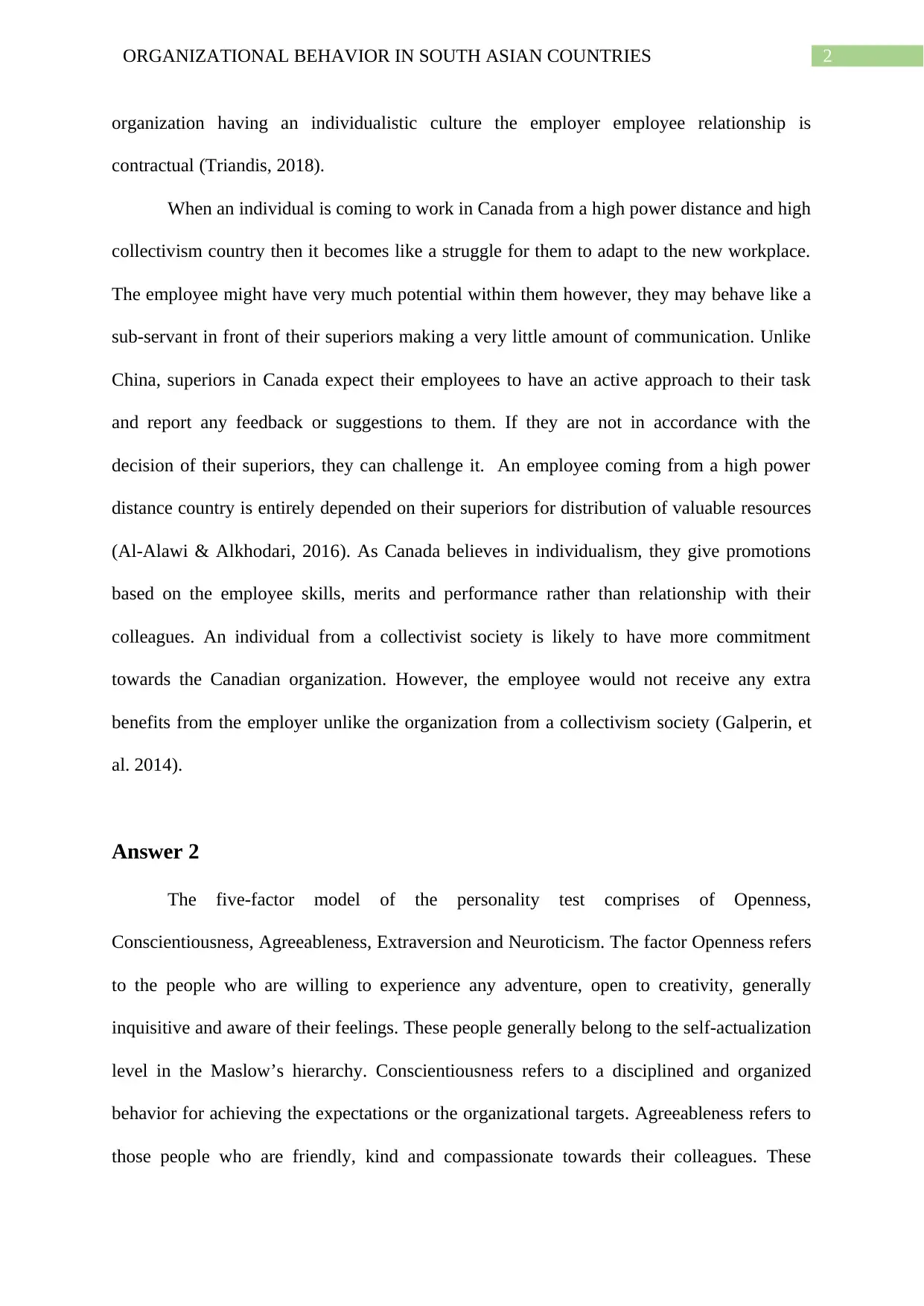
2ORGANIZATIONAL BEHAVIOR IN SOUTH ASIAN COUNTRIES
organization having an individualistic culture the employer employee relationship is
contractual (Triandis, 2018).
When an individual is coming to work in Canada from a high power distance and high
collectivism country then it becomes like a struggle for them to adapt to the new workplace.
The employee might have very much potential within them however, they may behave like a
sub-servant in front of their superiors making a very little amount of communication. Unlike
China, superiors in Canada expect their employees to have an active approach to their task
and report any feedback or suggestions to them. If they are not in accordance with the
decision of their superiors, they can challenge it. An employee coming from a high power
distance country is entirely depended on their superiors for distribution of valuable resources
(Al-Alawi & Alkhodari, 2016). As Canada believes in individualism, they give promotions
based on the employee skills, merits and performance rather than relationship with their
colleagues. An individual from a collectivist society is likely to have more commitment
towards the Canadian organization. However, the employee would not receive any extra
benefits from the employer unlike the organization from a collectivism society (Galperin, et
al. 2014).
Answer 2
The five-factor model of the personality test comprises of Openness,
Conscientiousness, Agreeableness, Extraversion and Neuroticism. The factor Openness refers
to the people who are willing to experience any adventure, open to creativity, generally
inquisitive and aware of their feelings. These people generally belong to the self-actualization
level in the Maslow’s hierarchy. Conscientiousness refers to a disciplined and organized
behavior for achieving the expectations or the organizational targets. Agreeableness refers to
those people who are friendly, kind and compassionate towards their colleagues. These
organization having an individualistic culture the employer employee relationship is
contractual (Triandis, 2018).
When an individual is coming to work in Canada from a high power distance and high
collectivism country then it becomes like a struggle for them to adapt to the new workplace.
The employee might have very much potential within them however, they may behave like a
sub-servant in front of their superiors making a very little amount of communication. Unlike
China, superiors in Canada expect their employees to have an active approach to their task
and report any feedback or suggestions to them. If they are not in accordance with the
decision of their superiors, they can challenge it. An employee coming from a high power
distance country is entirely depended on their superiors for distribution of valuable resources
(Al-Alawi & Alkhodari, 2016). As Canada believes in individualism, they give promotions
based on the employee skills, merits and performance rather than relationship with their
colleagues. An individual from a collectivist society is likely to have more commitment
towards the Canadian organization. However, the employee would not receive any extra
benefits from the employer unlike the organization from a collectivism society (Galperin, et
al. 2014).
Answer 2
The five-factor model of the personality test comprises of Openness,
Conscientiousness, Agreeableness, Extraversion and Neuroticism. The factor Openness refers
to the people who are willing to experience any adventure, open to creativity, generally
inquisitive and aware of their feelings. These people generally belong to the self-actualization
level in the Maslow’s hierarchy. Conscientiousness refers to a disciplined and organized
behavior for achieving the expectations or the organizational targets. Agreeableness refers to
those people who are friendly, kind and compassionate towards their colleagues. These
⊘ This is a preview!⊘
Do you want full access?
Subscribe today to unlock all pages.

Trusted by 1+ million students worldwide
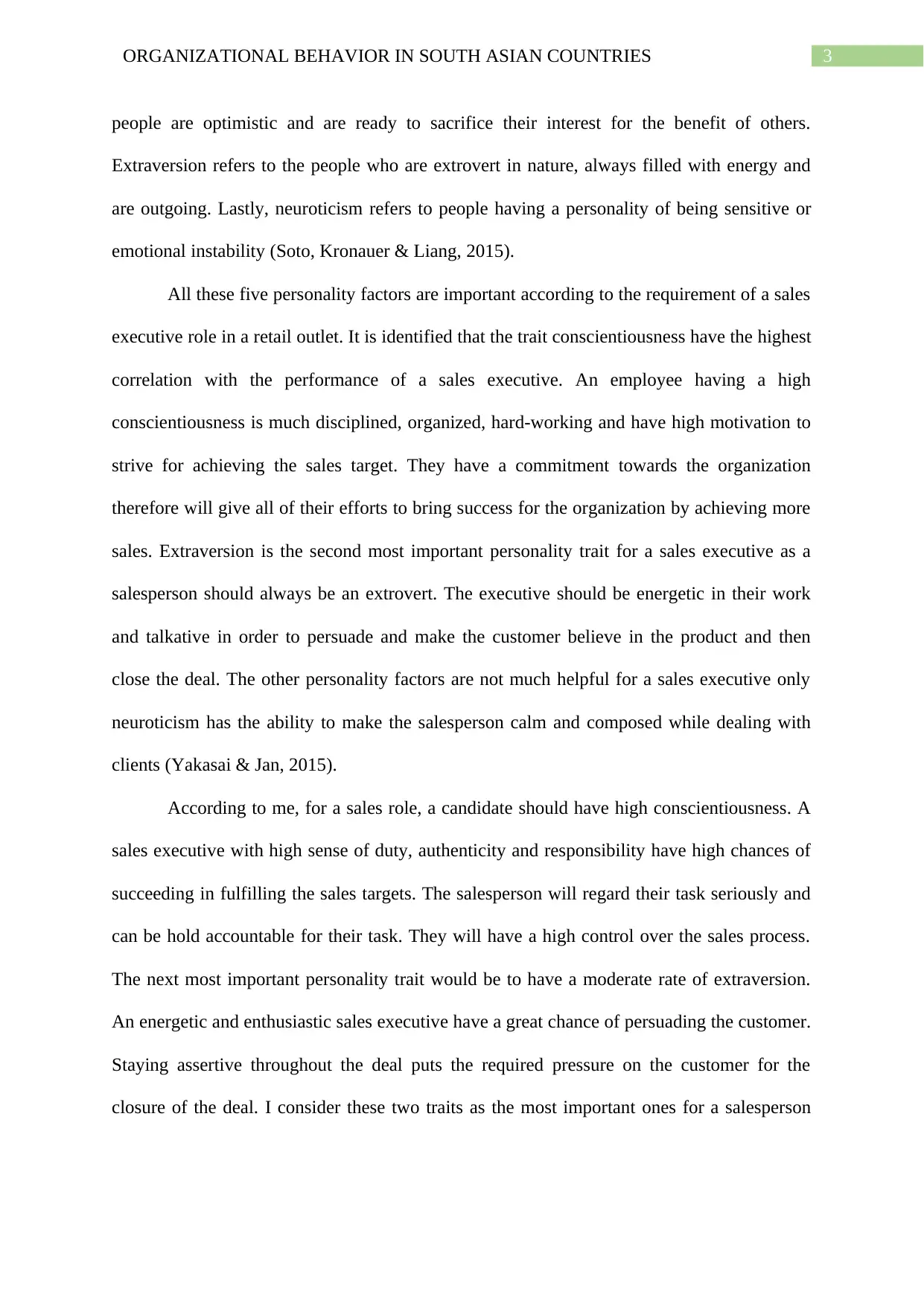
3ORGANIZATIONAL BEHAVIOR IN SOUTH ASIAN COUNTRIES
people are optimistic and are ready to sacrifice their interest for the benefit of others.
Extraversion refers to the people who are extrovert in nature, always filled with energy and
are outgoing. Lastly, neuroticism refers to people having a personality of being sensitive or
emotional instability (Soto, Kronauer & Liang, 2015).
All these five personality factors are important according to the requirement of a sales
executive role in a retail outlet. It is identified that the trait conscientiousness have the highest
correlation with the performance of a sales executive. An employee having a high
conscientiousness is much disciplined, organized, hard-working and have high motivation to
strive for achieving the sales target. They have a commitment towards the organization
therefore will give all of their efforts to bring success for the organization by achieving more
sales. Extraversion is the second most important personality trait for a sales executive as a
salesperson should always be an extrovert. The executive should be energetic in their work
and talkative in order to persuade and make the customer believe in the product and then
close the deal. The other personality factors are not much helpful for a sales executive only
neuroticism has the ability to make the salesperson calm and composed while dealing with
clients (Yakasai & Jan, 2015).
According to me, for a sales role, a candidate should have high conscientiousness. A
sales executive with high sense of duty, authenticity and responsibility have high chances of
succeeding in fulfilling the sales targets. The salesperson will regard their task seriously and
can be hold accountable for their task. They will have a high control over the sales process.
The next most important personality trait would be to have a moderate rate of extraversion.
An energetic and enthusiastic sales executive have a great chance of persuading the customer.
Staying assertive throughout the deal puts the required pressure on the customer for the
closure of the deal. I consider these two traits as the most important ones for a salesperson
people are optimistic and are ready to sacrifice their interest for the benefit of others.
Extraversion refers to the people who are extrovert in nature, always filled with energy and
are outgoing. Lastly, neuroticism refers to people having a personality of being sensitive or
emotional instability (Soto, Kronauer & Liang, 2015).
All these five personality factors are important according to the requirement of a sales
executive role in a retail outlet. It is identified that the trait conscientiousness have the highest
correlation with the performance of a sales executive. An employee having a high
conscientiousness is much disciplined, organized, hard-working and have high motivation to
strive for achieving the sales target. They have a commitment towards the organization
therefore will give all of their efforts to bring success for the organization by achieving more
sales. Extraversion is the second most important personality trait for a sales executive as a
salesperson should always be an extrovert. The executive should be energetic in their work
and talkative in order to persuade and make the customer believe in the product and then
close the deal. The other personality factors are not much helpful for a sales executive only
neuroticism has the ability to make the salesperson calm and composed while dealing with
clients (Yakasai & Jan, 2015).
According to me, for a sales role, a candidate should have high conscientiousness. A
sales executive with high sense of duty, authenticity and responsibility have high chances of
succeeding in fulfilling the sales targets. The salesperson will regard their task seriously and
can be hold accountable for their task. They will have a high control over the sales process.
The next most important personality trait would be to have a moderate rate of extraversion.
An energetic and enthusiastic sales executive have a great chance of persuading the customer.
Staying assertive throughout the deal puts the required pressure on the customer for the
closure of the deal. I consider these two traits as the most important ones for a salesperson
Paraphrase This Document
Need a fresh take? Get an instant paraphrase of this document with our AI Paraphraser
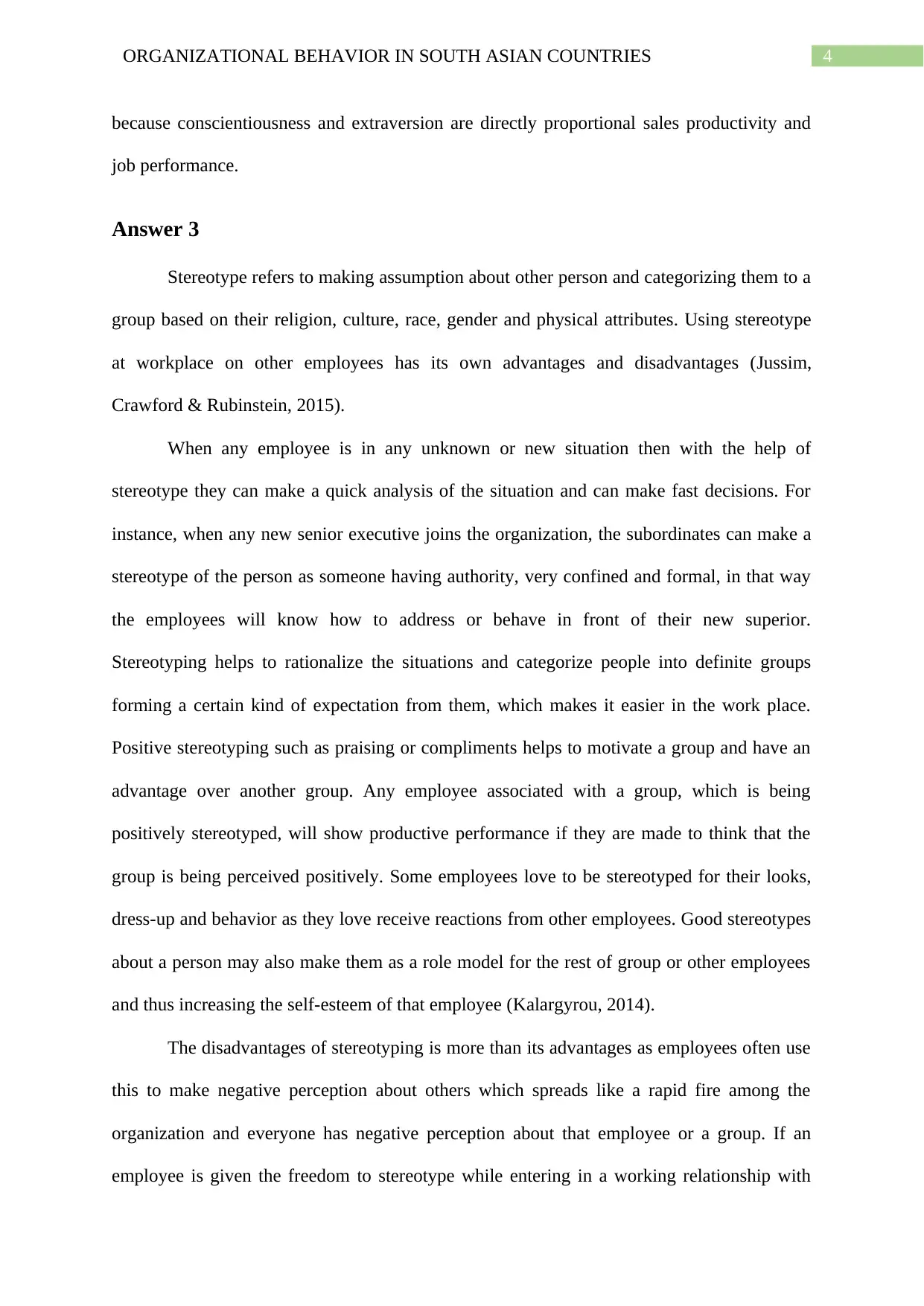
4ORGANIZATIONAL BEHAVIOR IN SOUTH ASIAN COUNTRIES
because conscientiousness and extraversion are directly proportional sales productivity and
job performance.
Answer 3
Stereotype refers to making assumption about other person and categorizing them to a
group based on their religion, culture, race, gender and physical attributes. Using stereotype
at workplace on other employees has its own advantages and disadvantages (Jussim,
Crawford & Rubinstein, 2015).
When any employee is in any unknown or new situation then with the help of
stereotype they can make a quick analysis of the situation and can make fast decisions. For
instance, when any new senior executive joins the organization, the subordinates can make a
stereotype of the person as someone having authority, very confined and formal, in that way
the employees will know how to address or behave in front of their new superior.
Stereotyping helps to rationalize the situations and categorize people into definite groups
forming a certain kind of expectation from them, which makes it easier in the work place.
Positive stereotyping such as praising or compliments helps to motivate a group and have an
advantage over another group. Any employee associated with a group, which is being
positively stereotyped, will show productive performance if they are made to think that the
group is being perceived positively. Some employees love to be stereotyped for their looks,
dress-up and behavior as they love receive reactions from other employees. Good stereotypes
about a person may also make them as a role model for the rest of group or other employees
and thus increasing the self-esteem of that employee (Kalargyrou, 2014).
The disadvantages of stereotyping is more than its advantages as employees often use
this to make negative perception about others which spreads like a rapid fire among the
organization and everyone has negative perception about that employee or a group. If an
employee is given the freedom to stereotype while entering in a working relationship with
because conscientiousness and extraversion are directly proportional sales productivity and
job performance.
Answer 3
Stereotype refers to making assumption about other person and categorizing them to a
group based on their religion, culture, race, gender and physical attributes. Using stereotype
at workplace on other employees has its own advantages and disadvantages (Jussim,
Crawford & Rubinstein, 2015).
When any employee is in any unknown or new situation then with the help of
stereotype they can make a quick analysis of the situation and can make fast decisions. For
instance, when any new senior executive joins the organization, the subordinates can make a
stereotype of the person as someone having authority, very confined and formal, in that way
the employees will know how to address or behave in front of their new superior.
Stereotyping helps to rationalize the situations and categorize people into definite groups
forming a certain kind of expectation from them, which makes it easier in the work place.
Positive stereotyping such as praising or compliments helps to motivate a group and have an
advantage over another group. Any employee associated with a group, which is being
positively stereotyped, will show productive performance if they are made to think that the
group is being perceived positively. Some employees love to be stereotyped for their looks,
dress-up and behavior as they love receive reactions from other employees. Good stereotypes
about a person may also make them as a role model for the rest of group or other employees
and thus increasing the self-esteem of that employee (Kalargyrou, 2014).
The disadvantages of stereotyping is more than its advantages as employees often use
this to make negative perception about others which spreads like a rapid fire among the
organization and everyone has negative perception about that employee or a group. If an
employee is given the freedom to stereotype while entering in a working relationship with
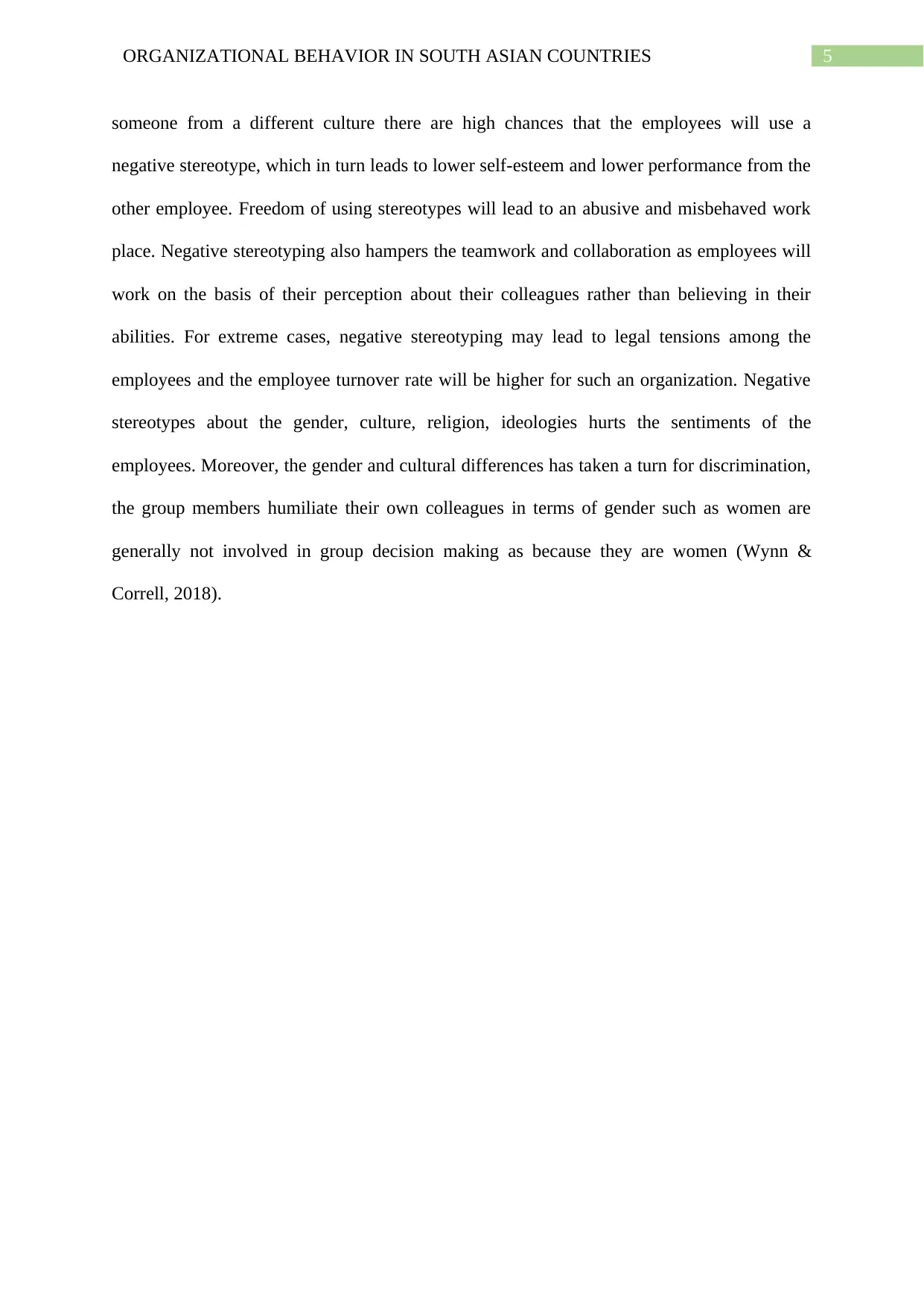
5ORGANIZATIONAL BEHAVIOR IN SOUTH ASIAN COUNTRIES
someone from a different culture there are high chances that the employees will use a
negative stereotype, which in turn leads to lower self-esteem and lower performance from the
other employee. Freedom of using stereotypes will lead to an abusive and misbehaved work
place. Negative stereotyping also hampers the teamwork and collaboration as employees will
work on the basis of their perception about their colleagues rather than believing in their
abilities. For extreme cases, negative stereotyping may lead to legal tensions among the
employees and the employee turnover rate will be higher for such an organization. Negative
stereotypes about the gender, culture, religion, ideologies hurts the sentiments of the
employees. Moreover, the gender and cultural differences has taken a turn for discrimination,
the group members humiliate their own colleagues in terms of gender such as women are
generally not involved in group decision making as because they are women (Wynn &
Correll, 2018).
someone from a different culture there are high chances that the employees will use a
negative stereotype, which in turn leads to lower self-esteem and lower performance from the
other employee. Freedom of using stereotypes will lead to an abusive and misbehaved work
place. Negative stereotyping also hampers the teamwork and collaboration as employees will
work on the basis of their perception about their colleagues rather than believing in their
abilities. For extreme cases, negative stereotyping may lead to legal tensions among the
employees and the employee turnover rate will be higher for such an organization. Negative
stereotypes about the gender, culture, religion, ideologies hurts the sentiments of the
employees. Moreover, the gender and cultural differences has taken a turn for discrimination,
the group members humiliate their own colleagues in terms of gender such as women are
generally not involved in group decision making as because they are women (Wynn &
Correll, 2018).
⊘ This is a preview!⊘
Do you want full access?
Subscribe today to unlock all pages.

Trusted by 1+ million students worldwide
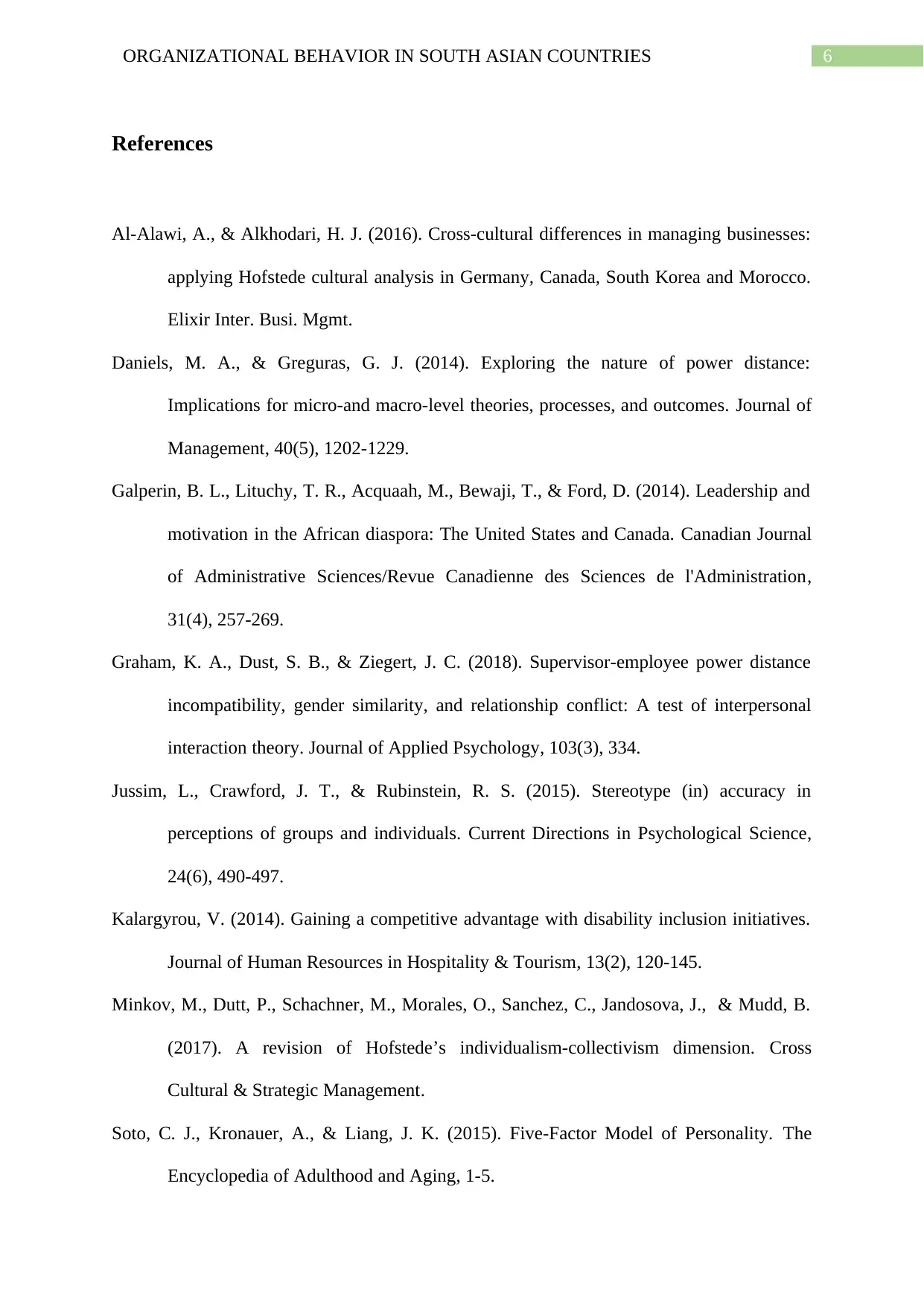
6ORGANIZATIONAL BEHAVIOR IN SOUTH ASIAN COUNTRIES
References
Al-Alawi, A., & Alkhodari, H. J. (2016). Cross-cultural differences in managing businesses:
applying Hofstede cultural analysis in Germany, Canada, South Korea and Morocco.
Elixir Inter. Busi. Mgmt.
Daniels, M. A., & Greguras, G. J. (2014). Exploring the nature of power distance:
Implications for micro-and macro-level theories, processes, and outcomes. Journal of
Management, 40(5), 1202-1229.
Galperin, B. L., Lituchy, T. R., Acquaah, M., Bewaji, T., & Ford, D. (2014). Leadership and
motivation in the African diaspora: The United States and Canada. Canadian Journal
of Administrative Sciences/Revue Canadienne des Sciences de l'Administration,
31(4), 257-269.
Graham, K. A., Dust, S. B., & Ziegert, J. C. (2018). Supervisor-employee power distance
incompatibility, gender similarity, and relationship conflict: A test of interpersonal
interaction theory. Journal of Applied Psychology, 103(3), 334.
Jussim, L., Crawford, J. T., & Rubinstein, R. S. (2015). Stereotype (in) accuracy in
perceptions of groups and individuals. Current Directions in Psychological Science,
24(6), 490-497.
Kalargyrou, V. (2014). Gaining a competitive advantage with disability inclusion initiatives.
Journal of Human Resources in Hospitality & Tourism, 13(2), 120-145.
Minkov, M., Dutt, P., Schachner, M., Morales, O., Sanchez, C., Jandosova, J., & Mudd, B.
(2017). A revision of Hofstede’s individualism-collectivism dimension. Cross
Cultural & Strategic Management.
Soto, C. J., Kronauer, A., & Liang, J. K. (2015). Five‐Factor Model of Personality. The
Encyclopedia of Adulthood and Aging, 1-5.
References
Al-Alawi, A., & Alkhodari, H. J. (2016). Cross-cultural differences in managing businesses:
applying Hofstede cultural analysis in Germany, Canada, South Korea and Morocco.
Elixir Inter. Busi. Mgmt.
Daniels, M. A., & Greguras, G. J. (2014). Exploring the nature of power distance:
Implications for micro-and macro-level theories, processes, and outcomes. Journal of
Management, 40(5), 1202-1229.
Galperin, B. L., Lituchy, T. R., Acquaah, M., Bewaji, T., & Ford, D. (2014). Leadership and
motivation in the African diaspora: The United States and Canada. Canadian Journal
of Administrative Sciences/Revue Canadienne des Sciences de l'Administration,
31(4), 257-269.
Graham, K. A., Dust, S. B., & Ziegert, J. C. (2018). Supervisor-employee power distance
incompatibility, gender similarity, and relationship conflict: A test of interpersonal
interaction theory. Journal of Applied Psychology, 103(3), 334.
Jussim, L., Crawford, J. T., & Rubinstein, R. S. (2015). Stereotype (in) accuracy in
perceptions of groups and individuals. Current Directions in Psychological Science,
24(6), 490-497.
Kalargyrou, V. (2014). Gaining a competitive advantage with disability inclusion initiatives.
Journal of Human Resources in Hospitality & Tourism, 13(2), 120-145.
Minkov, M., Dutt, P., Schachner, M., Morales, O., Sanchez, C., Jandosova, J., & Mudd, B.
(2017). A revision of Hofstede’s individualism-collectivism dimension. Cross
Cultural & Strategic Management.
Soto, C. J., Kronauer, A., & Liang, J. K. (2015). Five‐Factor Model of Personality. The
Encyclopedia of Adulthood and Aging, 1-5.
Paraphrase This Document
Need a fresh take? Get an instant paraphrase of this document with our AI Paraphraser
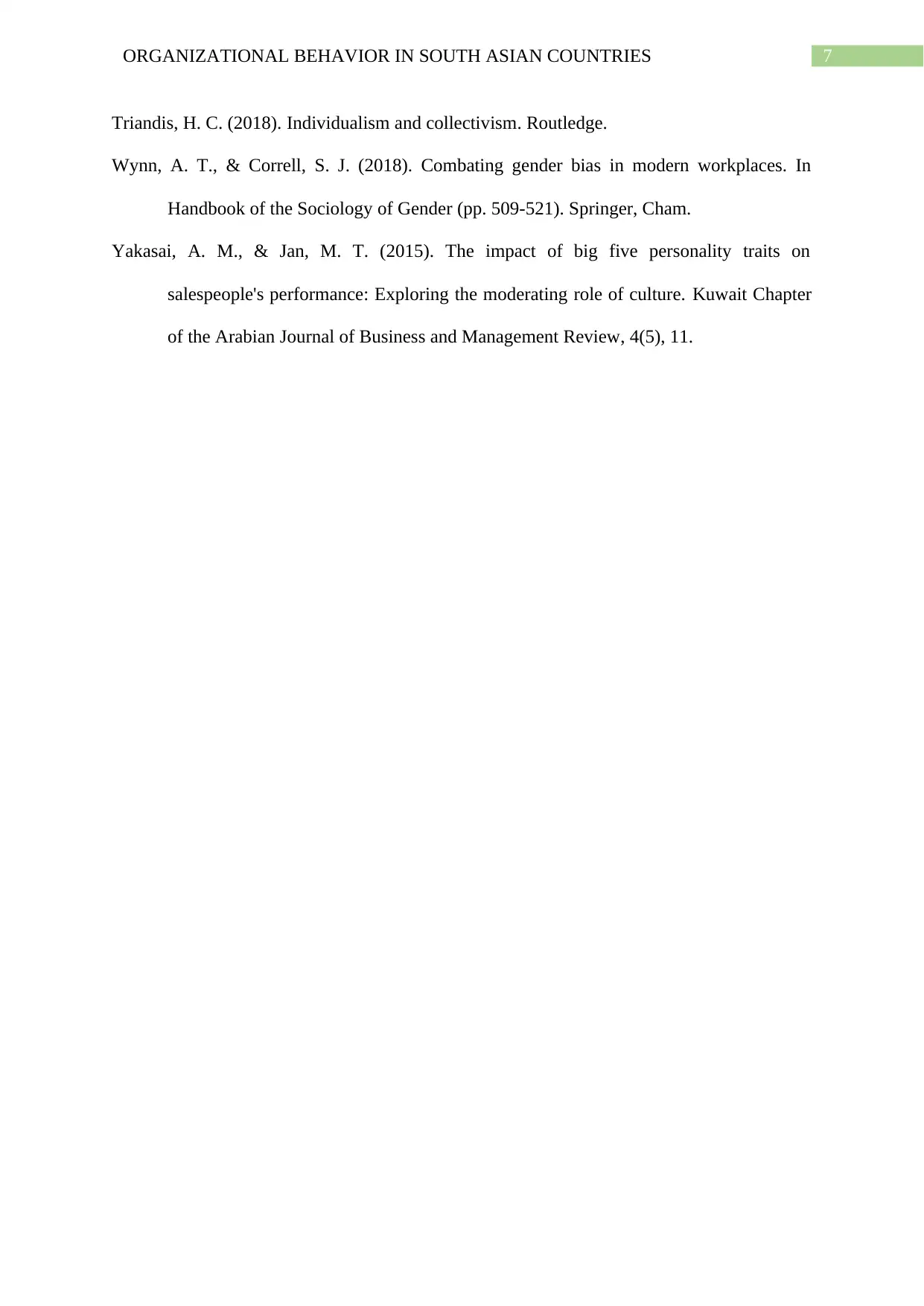
7ORGANIZATIONAL BEHAVIOR IN SOUTH ASIAN COUNTRIES
Triandis, H. C. (2018). Individualism and collectivism. Routledge.
Wynn, A. T., & Correll, S. J. (2018). Combating gender bias in modern workplaces. In
Handbook of the Sociology of Gender (pp. 509-521). Springer, Cham.
Yakasai, A. M., & Jan, M. T. (2015). The impact of big five personality traits on
salespeople's performance: Exploring the moderating role of culture. Kuwait Chapter
of the Arabian Journal of Business and Management Review, 4(5), 11.
Triandis, H. C. (2018). Individualism and collectivism. Routledge.
Wynn, A. T., & Correll, S. J. (2018). Combating gender bias in modern workplaces. In
Handbook of the Sociology of Gender (pp. 509-521). Springer, Cham.
Yakasai, A. M., & Jan, M. T. (2015). The impact of big five personality traits on
salespeople's performance: Exploring the moderating role of culture. Kuwait Chapter
of the Arabian Journal of Business and Management Review, 4(5), 11.
1 out of 8
Related Documents
Your All-in-One AI-Powered Toolkit for Academic Success.
+13062052269
info@desklib.com
Available 24*7 on WhatsApp / Email
![[object Object]](/_next/static/media/star-bottom.7253800d.svg)
Unlock your academic potential
Copyright © 2020–2025 A2Z Services. All Rights Reserved. Developed and managed by ZUCOL.





